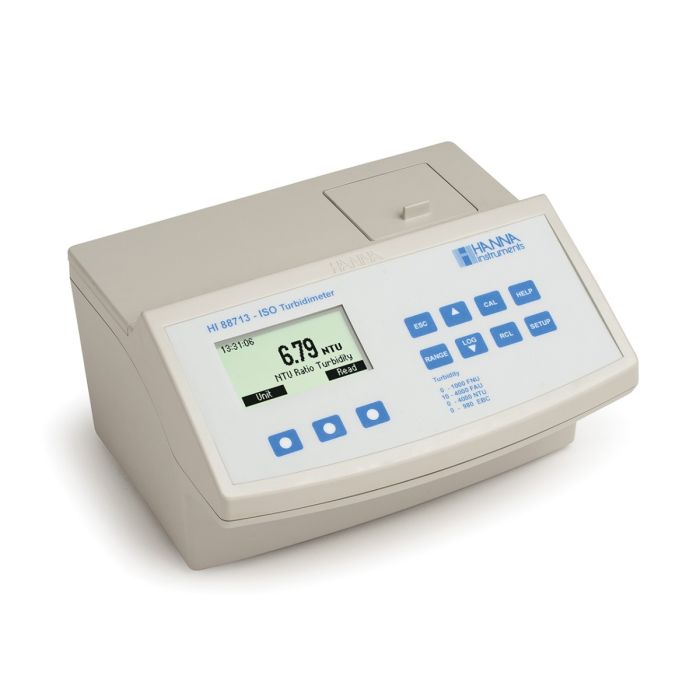Features at-a-glance:
Four Measurement Modes – The HI88713 features four options for turbidity measurement: FNU (Formazin Nephelometric Units), FAU (Formazin Attenuation Units), and NTU (Nephelometric Turbidity Units) ratio and non-ratio mode. Turbidity ranges for each mode are 0.00 to 1000 FNU, 10.0 to 4000 FAU, 0.00 to 4000 NTU (ratio mode), and 0.00 to 1000 NTU (non-ratio mode).
Multiple Turbidity Units of Measure – Turbidity can be read as Formazin Nephelometric Units (FNU), Formazin Attenuation Units (FAU), European Brewing Convention units (EBC), and Nephelometric Turbidity Units (NTU).
ISO Compliant – The HI88713 meets and exceeds the requirements of ISO 7027 method for turbidity measurements by use of an infrared LED light source.
Calibration – The HI88713 has a powerful calibration function that compensates for variation in light intensity. The calibration can be done using the supplied calibration solutions or user-prepared standards. A two, three, four, or five-point turbidity calibration can be performed by using the supplied (<0.10, 15, 100, 750 FNU, and 2000 NTU) standards. Calibration points can be modified if user-prepared standards are used.
AMCO AEPA-1 Primary Turbidity Standard – The AMCO AEPA-1 supplied standards are recognized as a primary standard by the USEPA. These non-toxic standards are made of styrene divinylbenzene polymer spheres that are uniform in size and density. The standards are reusable and stable with a long shelf life.
GLP Data – The HI88713 features complete GLP (Good Laboratory Practice) functions that allow traceability of the calibration conditions. Data includes calibration points, date, and time.
Data Logging – Up to 200 measurements can be stored in the internal memory and recalled at any time.
Data Transfer – For further storage or analysis options, logged data can be downloaded to a Windows compatible PC using the USB port and the HI92000 software.
Tutorial Mode – The unique tutorial mode provides additional information to help the user during measurements. When enabled, the instrument displays explanations and a confirmation button when a preparation or other operation has to be performed.
Contextual Help – Contextual help is always available through a dedicated HELP button. Clear tutorial messages and directions are available on-screen to quickly and easily guide users through setup and calibration. The help information displayed is relative to the setting/option being viewed.

